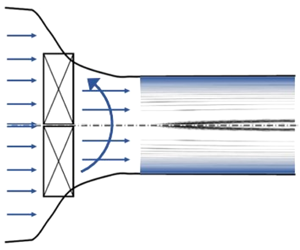No CrossRef data available.
Published online by Cambridge University Press: 07 January 2020

A small-disturbance model is presented for the complex dynamics of vortex flows of moist air in a straight, circular pipe with non-equilibrium and homogeneous condensation. The model explores the nonlinear interactions among the vortex near-critical swirl ratio and the small amount of water vapour in the air. The condensation rate is calculated according to classical nucleation and droplet growth models. The asymptotic analysis gives the similarity parameters that govern the flow problem. These are the flow inlet swirl ratio  $\unicode[STIX]{x1D714}$, the inlet Mach number
$\unicode[STIX]{x1D714}$, the inlet Mach number  $Ma_{0}$, the initial humidity
$Ma_{0}$, the initial humidity  $\tilde{\unicode[STIX]{x1D714}}_{0}$, the number of water molecules in a characteristic fluid element
$\tilde{\unicode[STIX]{x1D714}}_{0}$, the number of water molecules in a characteristic fluid element  $n_{C}$, the inlet centreline super-saturation ratio
$n_{C}$, the inlet centreline super-saturation ratio  $S_{0}$ and the ratio of characteristic condensation and flow time scales
$S_{0}$ and the ratio of characteristic condensation and flow time scales  $K$. Also, the flow field may be described by an ordinary first-order nonlinear differential equation for the flow evolution coupled with a set of four first-order ordinary differential equations along the pipe for the calculation of the condensate mass fraction. An iterative numerical scheme which combines the Runge–Kutta integration technique for the flow dynamics with Simpson’s integration rule for the calculation of the condensation variables is developed. Specifically, equilibrium states are determined, including the possibility of the appearance of multiple states under the same boundary conditions, and the stability characteristics of these states are described. The model is used to study the effects of humidity and of energy supply from nanoscale condensation processes on the large-scale dynamics of vortex flows as well as the effect of flow swirl on condensation processes in swirling flows.
$K$. Also, the flow field may be described by an ordinary first-order nonlinear differential equation for the flow evolution coupled with a set of four first-order ordinary differential equations along the pipe for the calculation of the condensate mass fraction. An iterative numerical scheme which combines the Runge–Kutta integration technique for the flow dynamics with Simpson’s integration rule for the calculation of the condensation variables is developed. Specifically, equilibrium states are determined, including the possibility of the appearance of multiple states under the same boundary conditions, and the stability characteristics of these states are described. The model is used to study the effects of humidity and of energy supply from nanoscale condensation processes on the large-scale dynamics of vortex flows as well as the effect of flow swirl on condensation processes in swirling flows.